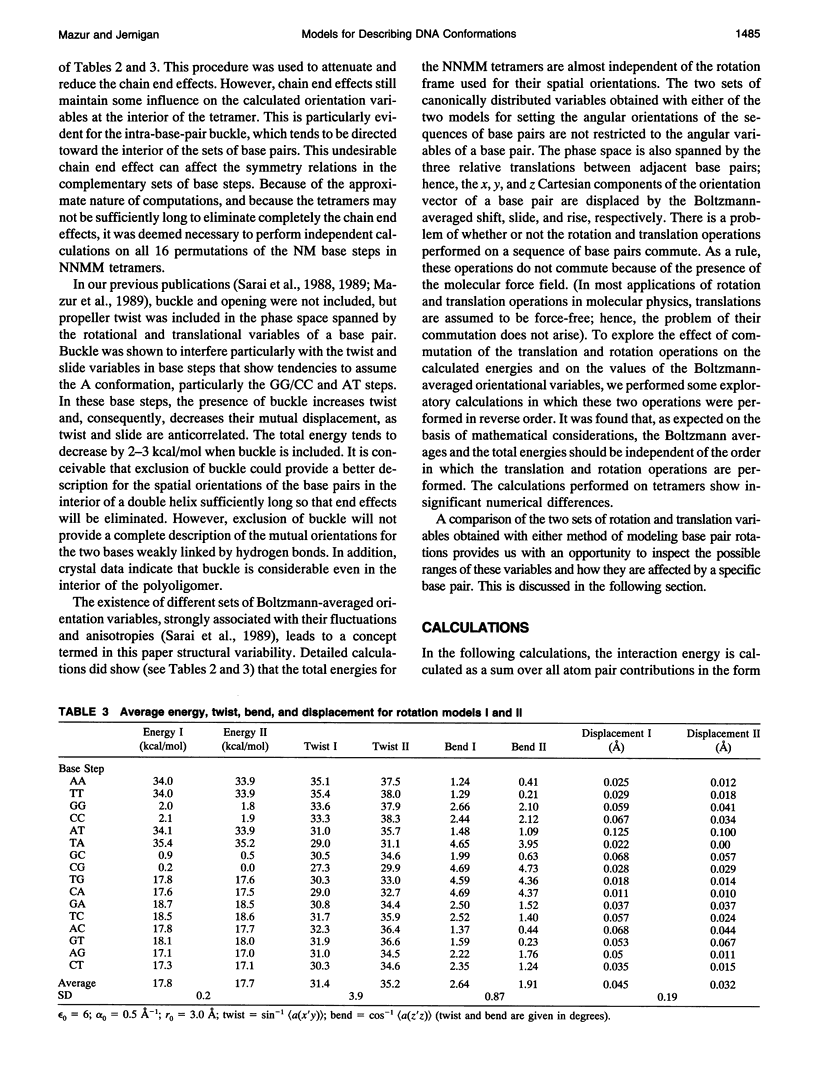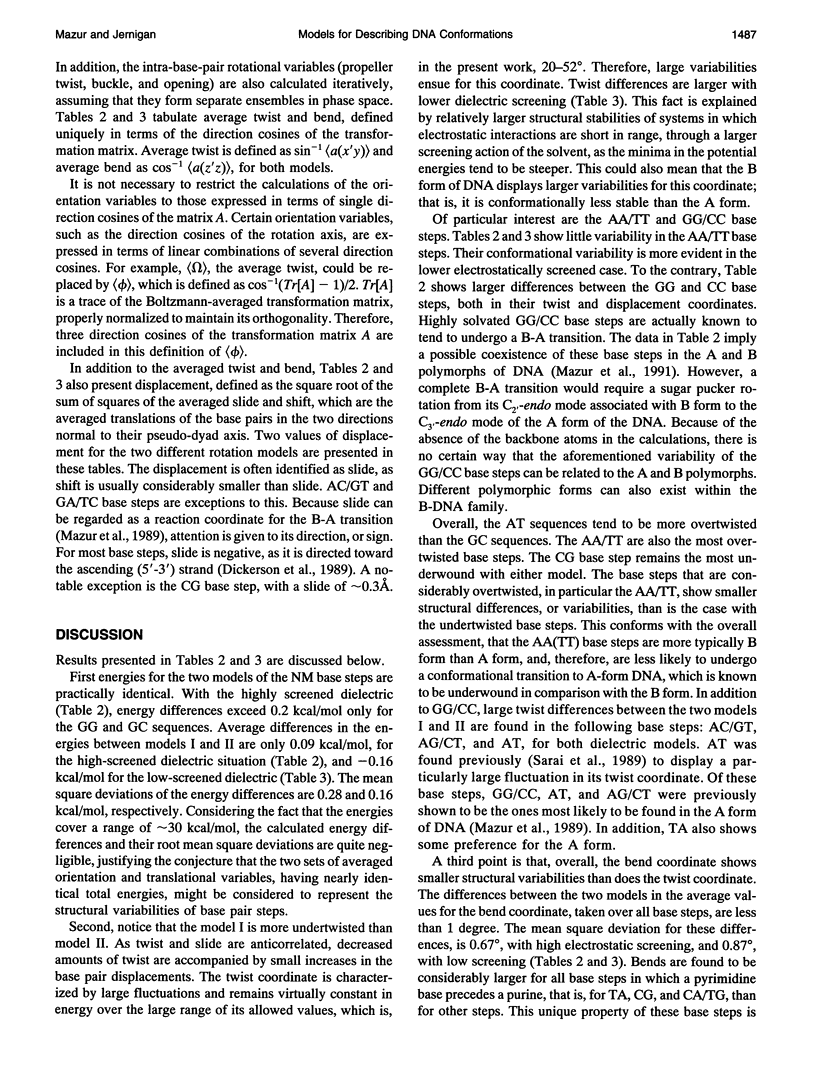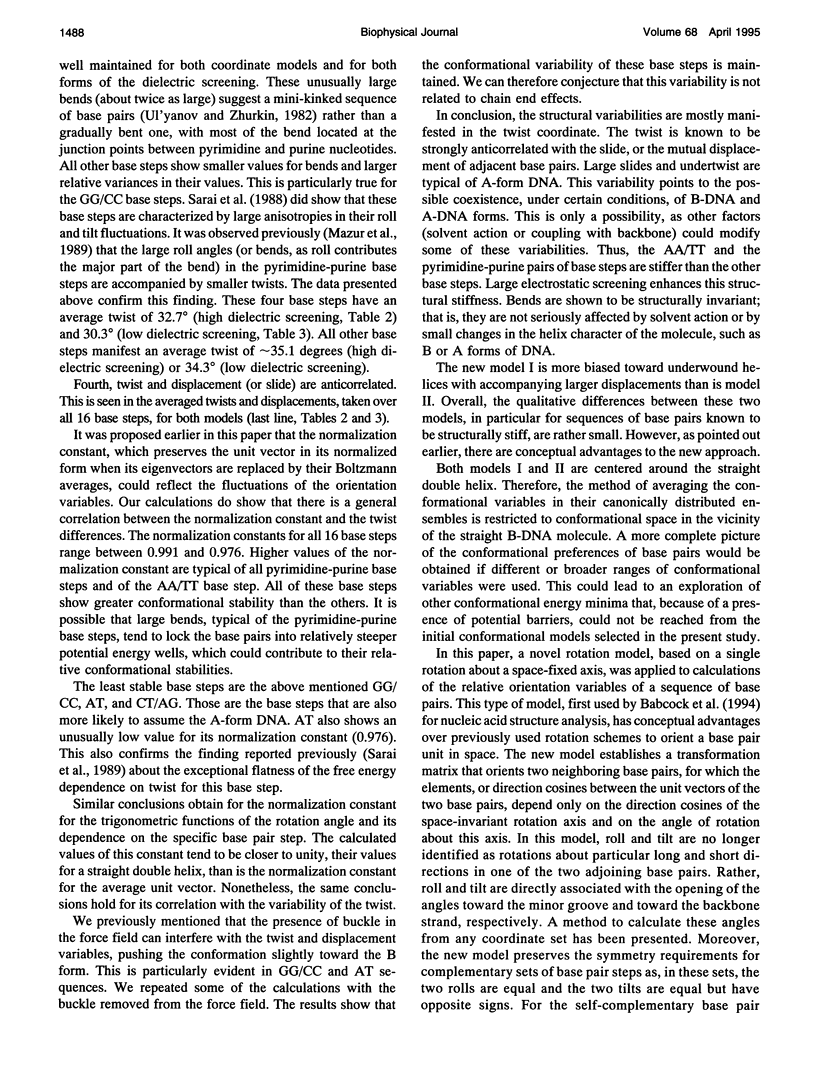Abstract
A new method, based on a space-fixed rotation axis, or local helix axis, is proposed for the calculation of the relative orientation variables for a sequence of base pairs. With this method, orientation variables are determined through the rotation of a base pair about this axis. These variables uniquely determine a set of helical variables, similar to the roll, tilt, and twist, commonly used for a description of spatial orientations of internally rigid base pairs. The proposed identification of roll and tilt with the direction cosines of the space-fixed rotation axis agrees well with their customary definitions as the openings of the angles between adjoining base pairs toward the minor groove and toward the ascending (5' to 3') backbone strand, respectively. These new variables permit a more direct physical comprehension of DNA conformations and also the behavior of self-complementary sequences. These direction cosines, together with the rotation angle about the space-fixed axis, form a set of three independent orientation variables of the bases that afford some advantages over the variously defined twist, roll, and tilt angles, either for static or average forms. An example for the static form of these variables is shown through their use to interpret crystal coordinates. An example for the average of orientation variables is based on statistical calculations. In this example, the orientation variables, together with the translational variables that describe the relative displacements of a pair of adjacent base pairs, form a canonically distributed ensemble in phase space spanned by these variables. Two sets of conformational variables are generated by using two different methods for performing rotation operations on the sequences of base pairs. The first method is based on the new single rotation about a space-fixed axis of rotation. This space-fixed axis of rotation is, in fact, the local helical axis as constructed previously by others. The second method is based on three consecutive rotations by Euler angles. Because of large flexibilities and anisotropies along various conformational variables of DNA base pairs, the two sets of generated conformational variables, based on these two different methods of performing rotation operations, lead to slightly different sets of structurally different, but energetically equivalent, spatial arrangements of the base pairs.
Full text
PDF

















Selected References
These references are in PubMed. This may not be the complete list of references from this article.
- Babcock M. S., Olson W. K. The effect of mathematics and coordinate system on comparability and "dependencies" of nucleic acid structure parameters. J Mol Biol. 1994 Mar 18;237(1):98–124. doi: 10.1006/jmbi.1994.1212. [DOI] [PubMed] [Google Scholar]
- Babcock M. S., Pednault E. P., Olson W. K. Nucleic acid structure analysis. Mathematics for local Cartesian and helical structure parameters that are truly comparable between structures. J Mol Biol. 1994 Mar 18;237(1):125–156. doi: 10.1006/jmbi.1994.1213. [DOI] [PubMed] [Google Scholar]
- Babcock M. S., Pednault E. P., Olson W. K. Nucleic acid structure analysis: a users guide to a collection of new analysis programs. J Biomol Struct Dyn. 1993 Dec;11(3):597–628. doi: 10.1080/07391102.1993.10508018. [DOI] [PubMed] [Google Scholar]
- Bernstein F. C., Koetzle T. F., Williams G. J., Meyer E. F., Jr, Brice M. D., Rodgers J. R., Kennard O., Shimanouchi T., Tasumi M. The Protein Data Bank: a computer-based archival file for macromolecular structures. J Mol Biol. 1977 May 25;112(3):535–542. doi: 10.1016/s0022-2836(77)80200-3. [DOI] [PubMed] [Google Scholar]
- Bhattacharya D., Bansal M. A general procedure for generation of curved DNA molecules. J Biomol Struct Dyn. 1988 Aug;6(1):93–104. doi: 10.1080/07391102.1988.10506484. [DOI] [PubMed] [Google Scholar]
- Bhattacharyya D., Bansal M. A self-consistent formulation for analysis and generation of non-uniform DNA structures. J Biomol Struct Dyn. 1989 Feb;6(4):635–653. doi: 10.1080/07391102.1989.10507727. [DOI] [PubMed] [Google Scholar]
- Definitions and nomenclature of nucleic acid structure parameters. EMBO J. 1989 Jan;8(1):1–4. doi: 10.1002/j.1460-2075.1989.tb03339.x. [DOI] [PMC free article] [PubMed] [Google Scholar]
- Dickerson R. E., Drew H. R. Structure of a B-DNA dodecamer. II. Influence of base sequence on helix structure. J Mol Biol. 1981 Jul 15;149(4):761–786. doi: 10.1016/0022-2836(81)90357-0. [DOI] [PubMed] [Google Scholar]
- Drew H. R., Wing R. M., Takano T., Broka C., Tanaka S., Itakura K., Dickerson R. E. Structure of a B-DNA dodecamer: conformation and dynamics. Proc Natl Acad Sci U S A. 1981 Apr;78(4):2179–2183. doi: 10.1073/pnas.78.4.2179. [DOI] [PMC free article] [PubMed] [Google Scholar]
- Fratini A. V., Kopka M. L., Drew H. R., Dickerson R. E. Reversible bending and helix geometry in a B-DNA dodecamer: CGCGAATTBrCGCG. J Biol Chem. 1982 Dec 25;257(24):14686–14707. [PubMed] [Google Scholar]
- Lavery R., Sklenar H. Defining the structure of irregular nucleic acids: conventions and principles. J Biomol Struct Dyn. 1989 Feb;6(4):655–667. doi: 10.1080/07391102.1989.10507728. [DOI] [PubMed] [Google Scholar]
- Lavery R., Sklenar H. The definition of generalized helicoidal parameters and of axis curvature for irregular nucleic acids. J Biomol Struct Dyn. 1988 Aug;6(1):63–91. doi: 10.1080/07391102.1988.10506483. [DOI] [PubMed] [Google Scholar]
- Marky N. L., Olson W. K. Configurational statistics of the DNA duplex: extended generator matrices to treat the rotations and translations of adjacent residues. Biopolymers. 1994 Jan;34(1):109–120. doi: 10.1002/bip.360340112. [DOI] [PubMed] [Google Scholar]
- Maroun R. C., Olson W. K. Base sequence effects in double-helical DNA. III. Average properties of curved DNA. Biopolymers. 1988 Apr;27(4):585–603. doi: 10.1002/bip.360270404. [DOI] [PubMed] [Google Scholar]
- Mazur J., Jernigan R. L. Distance-dependent dielectric constants and their application to double-helical DNA. Biopolymers. 1991 Nov;31(13):1615–1629. doi: 10.1002/bip.360311316. [DOI] [PubMed] [Google Scholar]
- Mazur J., Sarai A., Jernigan R. L. Sequence dependence of the B-A conformational transition of DNA. Biopolymers. 1989 Jul;28(7):1223–1233. doi: 10.1002/bip.360280704. [DOI] [PubMed] [Google Scholar]
- Olson W. K., Marky N. L., Jernigan R. L., Zhurkin V. B. Influence of fluctuations on DNA curvature. A comparison of flexible and static wedge models of intrinsically bent DNA. J Mol Biol. 1993 Jul 20;232(2):530–554. doi: 10.1006/jmbi.1993.1409. [DOI] [PubMed] [Google Scholar]
- Olson W. K., Srinivasan A. R. The translation of DNA primary base sequence into three-dimensional structure. Comput Appl Biosci. 1988 Mar;4(1):133–142. doi: 10.1093/bioinformatics/4.1.133. [DOI] [PubMed] [Google Scholar]
- Poltev V. I., Shulyupina N. V. Simulation of interactions between nucleic acid bases by refined atom-atom potential functions. J Biomol Struct Dyn. 1986 Feb;3(4):739–765. doi: 10.1080/07391102.1986.10508459. [DOI] [PubMed] [Google Scholar]
- Raghunathan G., Miles H. T., Sasisekharan V. Symmetry and molecular structure of a DNA triple helix: d(T)n.d(A)n.d(T)n. Biochemistry. 1993 Jan 19;32(2):455–462. doi: 10.1021/bi00053a009. [DOI] [PubMed] [Google Scholar]
- Sarai A., Mazur J., Nussinov R., Jernigan R. L. Sequence dependence of DNA conformational flexibility. Biochemistry. 1989 Sep 19;28(19):7842–7849. doi: 10.1021/bi00445a046. [DOI] [PubMed] [Google Scholar]
- Sklenar H., Lavery R., Pullman B. The flexibility of the nucleic acids: (I). "SIR", a novel approach to the variation of polymer geometry in constrained systems. J Biomol Struct Dyn. 1986 Apr;3(5):967–987. doi: 10.1080/07391102.1986.10508477. [DOI] [PubMed] [Google Scholar]
- Soumpasis D. M., Tung C. S. A rigorous basepair oriented description of DNA structures. J Biomol Struct Dyn. 1988 Dec;6(3):397–420. doi: 10.1080/07391102.1988.10506497. [DOI] [PubMed] [Google Scholar]
- Srinivasan R., Geetha V., Seetharaman J., Mohan S. A unique or essentially unique single parametric characterisation of biopolymeric structures. J Biomol Struct Dyn. 1993 Dec;11(3):583–596. doi: 10.1080/07391102.1993.10508017. [DOI] [PubMed] [Google Scholar]
- Ulanovsky L. E., Trifonov E. N. Estimation of wedge components in curved DNA. Nature. 1987 Apr 16;326(6114):720–722. doi: 10.1038/326720a0. [DOI] [PubMed] [Google Scholar]
- von Kitzing E., Diekmann S. Molecular mechanics calculations of dA12.dT12 and of the curved molecule d(GCTCGAAAAA)4.d(TTTTTCGAGC)4. Eur Biophys J. 1987;15(1):13–26. doi: 10.1007/BF00255031. [DOI] [PubMed] [Google Scholar]


